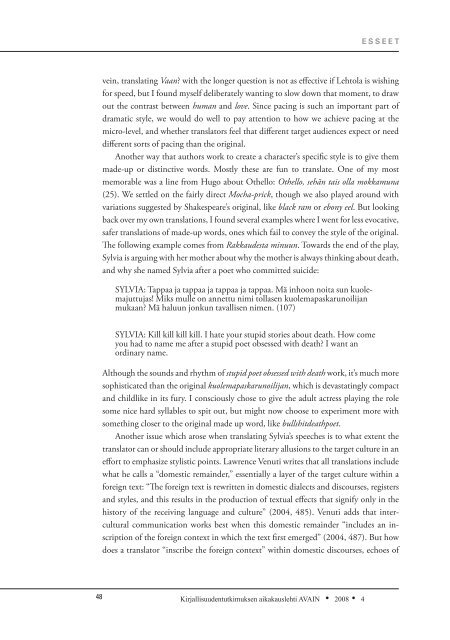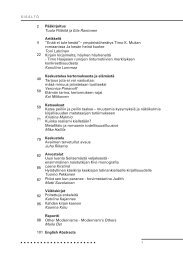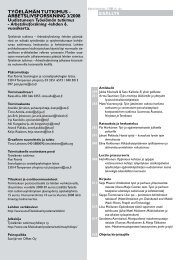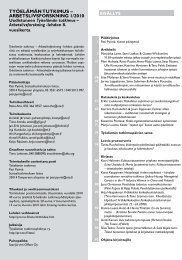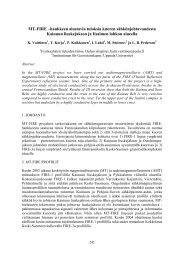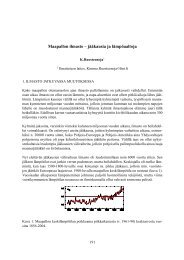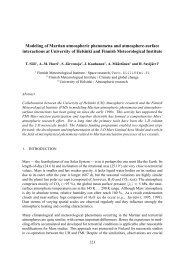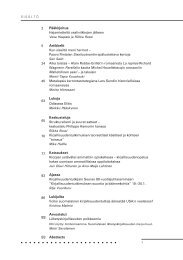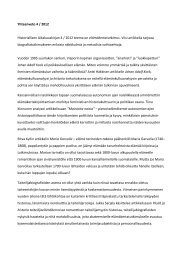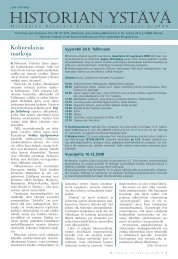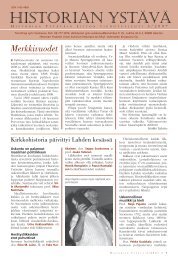Avain 4/2008
Avain 4/2008
Avain 4/2008
Create successful ePaper yourself
Turn your PDF publications into a flip-book with our unique Google optimized e-Paper software.
esseetvein, translating Vaan? with the longer question is not as effective if Lehtola is wishingfor speed, but I found myself deliberately wanting to slow down that moment, to drawout the contrast between human and love. Since pacing is such an important part ofdramatic style, we would do well to pay attention to how we achieve pacing at themicro-level, and whether translators feel that different target audiences expect or needdifferent sorts of pacing than the original.Another way that authors work to create a character’s specific style is to give themmade-up or distinctive words. Mostly these are fun to translate. One of my mostmemorable was a line from Hugo about Othello: Othello, sehän tais olla mokkamuna(25). We settled on the fairly direct Mocha-prick, though we also played around withvariations suggested by Shakespeare’s original, like black ram or ebony eel. But lookingback over my own translations, I found several examples where I went for less evocative,safer translations of made-up words, ones which fail to convey the style of the original.The following example comes from Rakkaudesta minuun. Towards the end of the play,Sylvia is arguing with her mother about why the mother is always thinking about death,and why she named Sylvia after a poet who committed suicide:SYLVIA: Tappaa ja tappaa ja tappaa ja tappaa. Mä inhoon noita sun kuolemajuttujas!Miks mulle on annettu nimi tollasen kuolemapaskarunoilijanmukaan? Mä haluun jonkun tavallisen nimen. (107)SYLVIA: Kill kill kill kill. I hate your stupid stories about death. How comeyou had to name me after a stupid poet obsessed with death? I want anordinary name.Although the sounds and rhythm of stupid poet obsessed with death work, it’s much moresophisticated than the original kuolemapaskarunoilijan, which is devastatingly compactand childlike in its fury. I consciously chose to give the adult actress playing the rolesome nice hard syllables to spit out, but might now choose to experiment more withsomething closer to the original made up word, like bullshitdeathpoet.Another issue which arose when translating Sylvia’s speeches is to what extent thetranslator can or should include appropriate literary allusions to the target culture in aneffort to emphasize stylistic points. Lawrence Venuti writes that all translations includewhat he calls a “domestic remainder,” essentially a layer of the target culture within aforeign text: “The foreign text is rewritten in domestic dialects and discourses, registersand styles, and this results in the production of textual effects that signify only in thehistory of the receiving language and culture” (2004, 485). Venuti adds that interculturalcommunication works best when this domestic remainder “includes an inscriptionof the foreign context in which the text first emerged” (2004, 487). But howdoes a translator “inscribe the foreign context” within domestic discourses, echoes of48Kirjallisuudentutkimuksen aikakauslehti AVAIN • <strong>2008</strong> • 4


